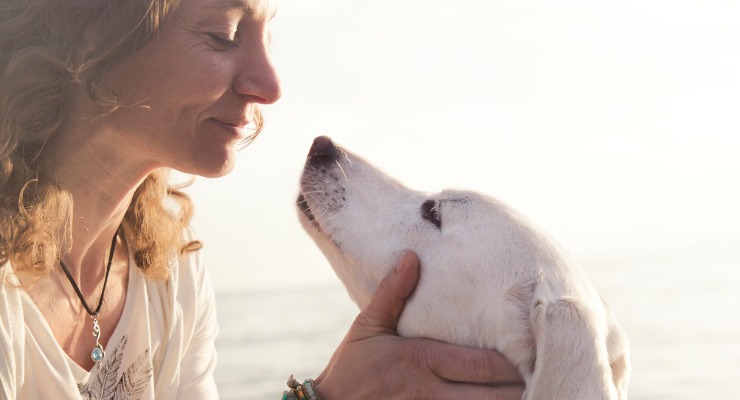
Dogs are intuitive. Those knowing eyes and a reassuring lick can do wonders for making us feel better when we’re down. Their sixth sense is finely tuned to how we feel. Have you ever wondered if your dog really knows how you’re feeling or is it just your imagination? There is evidence that some dogs are clever enough to tell if their owner or even a stranger is sad, happy, stressed, pregnant or ill.
Research shows some dogs can sense your mood and health condition.
Do Dogs Know When you are Sad?
If you have ever thought your dog knows when to give you a comforting lick or knowing snuggle, you are probably on to something.
Studies have found that dogs can actually recognise human emotions. They can even guess what their human’s emotion will be when they see the hole in the backyard (cue the guilty look).
It is thought adult dogs have a mind similar to that of a human toddler when it comes to mental abilities, emotional intelligence and vocabulary. Studies show that dogs are sensitive to emotional contagion which is responding to the emotions of another without understanding what they are feeling. Your dog knows you are experiencing poor feelings even if they aren’t sure how you feel, so they provide comfort.
In a study of 18 dogs published in an edition of the Animal Cognition journal, the University of London researchers looked at dogs’ reactions towards someone crying and humming. The experiments took place in the dogs’ homes. It was thought that humming was a new behaviour for most dogs and they would be naturally curious.
Fifteen of the 18 dogs showed submissive body language as they went to their crying owner or stranger.
How a Dog Can Show Empathy
Different dogs will display empathy in a range of ways including:
Touching their Owner
Many dogs will show comfort by putting their head on their owner’s lap, an outstretched paw or a lick on the hand.
Giving their Owner Space
Some dogs will do the opposite of touching their owner instead they will provide them with some space. After sensing the changed emotion of their owner, they move away until they think their owner is ready for their dog’s company again.
Distraction Method
Other dogs will try to cheer up their owner. They may drop the ball at their owner’s feet or encourage them to go outside with them. Just as we might try to take a toddler’s mind off something unpleasant a dog may try to do the same for their owner.
Do Dogs Know When you are Hurt or Ill?
Just as dogs can use our facial expressions as cues when we are happy, they can do the same to tell when their owner is hurt or ill. When you are injured or unwell, it’s likely you will have a different expression compared to your usual everyday face. This change in appearance and possibly your different behavior leads your dog to assume that you are hurt or ill.

Dogs have an excellent sense of smell, and some can even sniff out when a person is unwell. There have been cases where the average pet dog untrained in detecting illness has been able to save their owner’s life by detecting cancer. Studies have shown that dogs are particularly good a detecting lung and breast cancer. It is thought that the change in the patient’s exhaled breath leads the dog to make the link.
A study confirmed average pet dogs could be trained using a three-phase, food reward method could be used to detect lung and breast patients compared to a control group of people.
The five dogs used scent alone to detect the 55 lung cancers and 31 breast cancers in early and late-stage patients. Results showed scent detection compared to biopsy confirmation was 0.99% for lung cancer patients and 0.88 for breast cancer patients.
The International Journal of Gastroenterology and Hepatology reported a study where a Labrador Retriever was able to detect colorectal cancer with 0.91% accuracy and 0.99% accuracy in two sets of exhaled breath samples. The specially trained dog had even better results with stool samples being able to detect early signs of cancer with 0.97% and 0.99% accuracy.
Dogs have also been trained to sniff out cancer-specific volatile organic compounds. Cells in humans change when a heart attack is imminent, and dogs have been known to detect the smell of these changes, making them perfect as an early warning sign.
Dogs’ sense of smell is 10,000 times better than humans, and it is thought that up to one-third of their brain is devoted to their olfactory cells.
Animal-assisted therapy is becoming more widely used in the medical world. Doctors are reporting their patients are happier and healing faster due to the interactions a patient is having with a pet or other animal.
Do Dogs Know When you are Pregnant?
Many expectant mums-to-be had reported that their dog could sense their pregnancy, often before they even knew. The hormones that flood a pregnant woman’s body changes their scent. The change in odour can cause a dog to be more attentive, curious or confused. While they may recognise the scent changes, it is unlikely that they relate the pregnancy to the new baby in the house even after their owner has had multiple pregnancies.
Dogs not only have a far sharper sense of smell than humans they also have two senses of smell – one for picking up food odours and another for pheromones, known as the Jacobson’s organ or vomeronasal organ. Used primarily for reproduction behaviour through the perception of pheromones, Jacobson's organ can also be used to detect scent changes in humans.
A dog’s behaviour towards an owner’s pregnancy can be different in each case by. Generally, the pet is more protective, timid or acts more like a lap dog. Dogs may also pick up small changes in their owner’s behaviour. Going to bed earlier, waking at night, even decorating the nursery can all be picked up by dogs who are sensitive to our routine.
If a pregnant owner is anxious or emotional during pregnancy, their dog may pick up on the emotions. When close to mum, a dog may also be able to hear the heartbeat of the foetus in later pregnancy. A dog’s hearing range is 50,000 to 60,000 cycles, much higher than the 20,000 of humans. They may be able to hear the other organs and movements of the baby.
Do Dogs Know When you are Happy?
It seems a dog can tell when you are happy - although not just because of your facial expressions but by your feel-good hormones oxytocin, serotonin and dopamine. Our levels of these hormones become elevated when we feel happy, and it’s thought dogs can smell and sense the change.

Researchers in Vienna believe dogs are able to detect human emotions just by looking at pictures of faces. They recognised facial cues to determine if a person is happy or angry. It is thought to be the first evidence of an animal able to discriminate emotional expressions in another species. A professor at the University of Veterinary Medicine Vienna said the dogs in the study could tell the difference in expressions of both people they knew and people they had never seen before. Even more impressive, the dogs were only shown either the top or bottom half of the faces. It appeared the dogs could associate a happy face with a positive meaning and an angry face with a negative connotation.
In a University of Lincoln School of Psychology, a study showed that dogs can integrate two sources of sensory information into a coherent perception of emotion both in dogs and humans. With no prior training or familiarisation, it is thought the dog’s ability to combine emotional cues is intrinsic.
Do Dogs Know When you are Stressed?
Many dog owners will say their dog can sense their emotions of being stressed or depressed. Their dog will respond by acting differently toward them, have a concerned look or sit beside them to show support. While the dog probably won’t know what the emotion is or the cause, they will know that something is different and they need to support their owner. A dog will often slink away when its two owners argue, not wanting to be any part of the disagreement.
It is thought that dogs can smell fear and stress even when there are no other signs. A dog can smell the surge of hormones created by stress - including adrenaline and cortisol. In some cases, the dog has detected the increase of stress before their owner has even realised. Dogs can alert their owner to the change in emotional state to prevent a panic attack from occurring.
Owning a dog has been found to lift an owner’s mood and make them less stressed. A dog is an excellent companion for someone feeling stressed. They make excellent friends, take orders well (following training), and encourage their owner to get out of the house for walks, which also helps with stress and depression.
All of these qualities make dogs ideal for helping people deal with Post-Traumatic Stress Disorder (PTSD). An emotional support dog doesn’t need specialised training like service dogs, but they do have the qualities required for helping their owner with a mental health condition. However, it is thought that relying on a dog for emotional support may hamper its owner’s chances of doing things on their own.
Therapy dogs are becoming popular in schools, hospitals, dental offices and nursing homes. They are trained to comfort humans who are stressed, anxious, upset or just in need of some canine company to brighten their day.
Therapy dogs may have been trained as a service dog but not have met all of the strict certification criteria. However, their training means they are friendly and accepting of strangers, happy to sit in the one place for long periods of time, have good manners, and are focused and confident.
A Rhodesian ridgeback dog in France has been trained to detect high levels of cortisol in students. High cortisol levels are typical in students on the autism spectrum. As students file past the dog into school each morning. If a student has high cortisol levels, the dog will signal to her health teacher handler by staring at the student. The teacher can then work with the student on an individual level before a meltdown occurs.
Which Breeds Make the Best Service, Emotion and Medical Dogs?
All dogs can be trained to be assistance dogs, but some breeds are better suited than others. Assistance dogs need to be physically able in terms of their size, strength and stamina to perform their duties. They need to be energetic enough to carry heavy objects and walk long distances but also be happy to sit calmly for long stretches.
Service dog roles are often filled with intelligent, happy and energetic breeds such as golden retrievers, Labrador retrievers and German shepherds.
While most dog breeds are excellent companions and will help someone suffering stress or depression some dogs are better than others at helping to fight their owner’s depression. French bulldogs, King Charles spaniels and pugs have the ideal mix of bouncy energy, trainability and constant affection that make them perfect.
It is thought most dogs can sniff out medical and emotional conditions, but not all dogs are interested. The breeds used in the breast and lung cancer study were Labrador retrievers and Portuguese water dogs. German shepherds and Labradors have also been used to detect medical conditions.
It doesn’t really matter if your dog doesn’t have the qualities to be an emotion dog or the smarts to know how you are feeling. As long as they are there by your side as your companion when you need them, that’s all that counts.